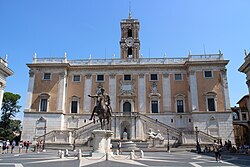
| Architecture of Italy |
|---|
 |
| Periods and styles |
| Palaces and gardens |
| Notable works |
| Notable architects |
| By region |
| Other topics |
This is a list of notable palaces in Italy , sorted by city.
Contents
- Acireale
- Alatri
- Albano Laziale
- Anagni
- Ancona
- Anzio
- Ariccia
- Ascoli Piceno
- Asti
- Atina
- Belluno
- Belmonte Calabro
- Bergamo
- Bernalda
- Bologna
- Bomarzo
- Brescia
- Brugherio
- Caltagirone
- Caprarola
- Caravaggio
- Caserta
- Castel Gandolfo
- Castel Goffredo
- Castiglione del Lago
- Catania
- Cavallino
- Cefalù
- Cesano Maderno
- Cesena
- Chiavenna
- Cingoli
- Città di Castello
- Cividale del Friuli
- Colorno
- Como
- Crema
- Cremona
- Domodossola
- Este
- Fano
- Fermo
- Ferrara
- Ficuzza
- Fiesole
- Fino Mornasco
- Florence
- Foggia
- Foligno
- Forlì
- Gaeta
- Garbagna Novarese
- Garessio
- Genoa
- Grosseto
- Grottaglie
- Gubbio
- Imola
- Jesi
- L'Aquila
- Legnano
- Lucca
- Macerata
- Merate
- Mirandola
- Mantua
- Marino
- Marmirolo
- Matera
- Messina
- Milan
- Modena
- Modica
- Moncalieri
- Montirone
- Montepulciano
- Naples
- Navelli
- Nicosia
- Novara
- Orvieto
- Padua
- Palermo
- Parma
- Pavia
- Perugia
- Pesaro
- Piacenza
- Pienza
- Piove di Sacco
- Pisa
- Pistoia
- Pontremoli
- Pordenone
- Porto Mantovano
- Potenza
- Prato
- Racconigi
- Ragusa
- Ravenna
- Reggio Emilia
- Rieti
- Rimini
- Rome
- Rosciano
- Rovigo
- Sabbioneta
- Salerno
- Saluzzo
- San Gimignano
- San Tammaro
- Sarzana
- Sassari
- Sassuolo
- Siena
- Somma Vesuviana
- Stupinigi
- Syracuse
- Taormina
- Teglio
- Terni
- Thiene
- Tirano
- Todi
- Trento
- Treviso
- Turin
- Udine
- Ugento
- Urbino
- Varese
- Venaria Reale
- Venice
- Verona
- Viareggio
- Vicenza
- Viterbo
- Volterra
- See also












![Palazzo del Comune, Cremona [it] Project 140917 4896.jpg](http://upload.wikimedia.org/wikipedia/commons/thumb/f/f1/Project_140917_4896.jpg/250px-Project_140917_4896.jpg)





















































